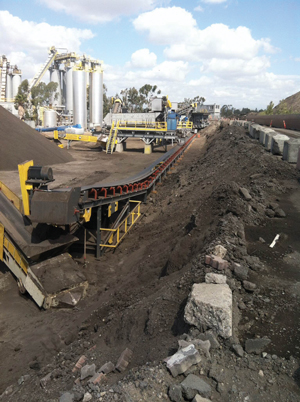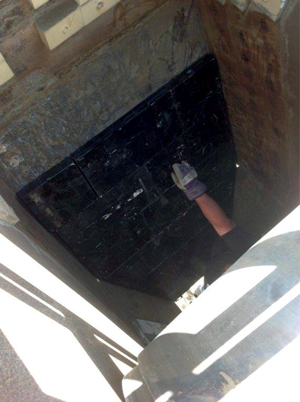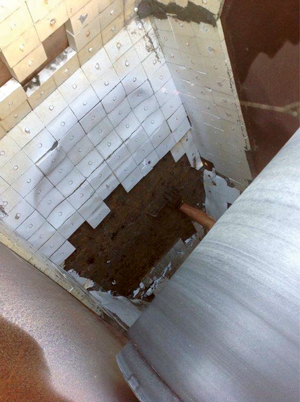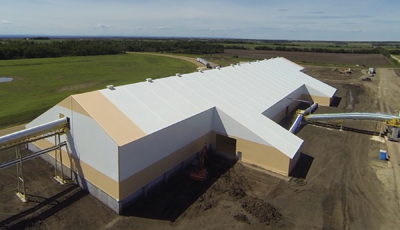A LOOK AT BELT TECHNOLOGY, THE CORE OF MINES’ MATERIAL HANDLING EFFICIENCY
By Donna Schmidt, Field Editor
Efficiency: it is a very broad term, but one which is crucial to every square inch of an operation. Without efficiency in one area, another suffers, while finding an efficient solution can, conversely, have a positive ripple effect on many other facets of the mine. Efficiency also comes in many forms; even the level of safety a site maintains can make or break its targets.
| Martin Engineering introduced a solution to reduce conveyor spillage from edge sag as well as belt wear at transfer points with a pair of conveyor system components, the EVO Slider Cradle and the Martin Slider Cradle. (Photo courtesy Martin Engineering) |
Keeping conveyor belts running efficiently, then, is inherently an arterial issue. Without belts to carry the load, coal would likely never leave the mine, let alone get to stockpiles or other storage areas into their mode of transport and off to the end user.
From safety mechanisms, longer belt lifespans, quicker and less expensive maintenance and reducing carryback, belt engineers are consistent in their efforts to find the “perfect” belt design — while operators continue to demand more and more of those designs. Fortunately, as widths, lengths and capacities grow, so do the research and design ideas of manufacturers.
A NEW DESIGN PERSPECTIVE
Cost of ownership has always been the focus of highlighted line items in mine budgets, and when it comes to belts, there is no shortcut to meeting a goal. Just like many other things in life, one often doesn’t get what they pay for, so purchase price and overall ownership cost must reside equally at the top of the priority list.
In mid-February, Martin Engineering introduced a brand new design for its belt cleaner that was engineered to contain a smaller total volume of urethane while maximizing the usable area.
Manufactured with the company’s CARP (Constant Angle Radial Pressure) technology to maintain the most efficient cleaning angle throughout its service life, the Martin QB1 Cleaner HD focuses on a no-tool replacement process that can be performed safely by one person in less than five minutes. “By minimizing the nonconsumable portion of the blade, the heavy-duty primary belt cleaner delivers the same performance and durability as the model it replaces, while reducing the amount of urethane going to landfills,” the company said, and global engineering manager Paul Harrison added that both the manufacturing process and blade itself were re-engineered and simplified to bring about the new release.
“The new profile will be less complex to produce, and because it can be roll formed or manufactured on a press brake, it will be easier to source throughout the world from any Martin Engineering manufacturing site,” he said.
The reduced weight will also facilitate easier blade replacement, and the one-pin mounting system helps reduce downtime for maintenance. When it does come time to replace the QB1, Harrison explained that the site’s maintenance personnel can simply pull the locking pin, unclamp the bracket and slide the blade out of the mainframe. The new precut blade is slipped onto the square mainframe and clamped.
CARP technology, designed to keep the blade at a consistent angle and pressure against the belt, is typically set at about 2 psi for the QB1 HD, and the low blade-to-belt pressure helps protect the belt, splice and cleaner itself. Neither the surface area nor the angle are compromised as the blade naturally wears, allowing for a longer life.
“To introduce material back into the product flow, the QB1 HD is installed on the face of the head pulley,” Harrison said. “On a dual cleaner system, the new pre-cleaner is installed immediately in front of the secondary cleaner.”
For applications involving enclosed pulley chutework, Martin Engineering recommends the installation of one of its steel inspection doors.
The redesigned cleaner was engineered under the company’s EVO philosophy, which re-examines every aspect of component design and function to achieve greater efficiency and fugitive material control.
“In addition to its cost advantages, the QB1 HD features a mainframe that has been rotated 45˚ to shed dust and spillage,” he said of the resulting new release. “The urethane formulation can accommodate belt speeds of up to 900 fpm (4.6 m/sec) and service temperatures of -40° to 160°F (-40° to 70°C).”
The QB1 HD is available in lengths of 18 to 96 in. (457 to 2438 mm) and can also be ordered in 10-ft (3.05 m) slugs, allowing the ability to cut to length. Additionally, the Martin official noted that a similar redesign can be applied to its other belt cleaners as well. Perhaps future product development is in the works?
Yes, according to Harrison. “We are always looking for ways to reduce our environmental footprint,” he said. “The fact that innovation is leading the way to a lower cost of ownership and reduced waste indicates that the bulk handling industry and environmentalism can work hand-in-hand.”
In January, Martin Engineering also introduced the result of its work to reduce conveyor spillage from edge sag as well as belt wear at transfer points with a pair of conveyor system components: the EVO Slider Cradle and the Martin Slider Cradle.
The two, which can both be located under the skirt board in the chute box after the impact cradle, utilize “double-life” slider bars to provide a low-friction seal, permitting a flat and stable belt surface throughout the settling zone. As a result, fugitive material is reduced and belt health can be extended.
As Daniel Marshall, Martin product engineer at the USA business unit, noted, transfer points are often prone to spillage as the conveyed material lands on the receiving conveyor.
“Once the belt leaves the impact cradle, it can sag while the material is still settling,” he said. “This compromises the skirt seal, allowing dust and fines to escape, while creating pinch points where material can get caught and gouge the belt.”
 |
| Superior Industries’ modular, pre-engineered Zipline conveyor system has been designed for coal as well as biomass, aggregates and marine applications. |
The Martin Engineering slider cradles, available in UHMW plastic or stainless steel, are designed for conveyor systems with speeds up to 700 fpm (3.5 m/sec) and belts lengths of more than 50 ft (15.2 m). Typically 48 in. (1,220 mm) long, the units are also available in custom sizes.
Center rollers also help reduce friction and energy consumption, and are suggested for applications where capacity is more than 450 tph (408 mtph). The idlers are optional on single bar Martin Slider Cradle designs and are standard on all other units, Marshall said.
The EVO Slider Cradle is manufactured to accommodate belt width sizes of 36 in. (915 mm) for single bar models and 42-60 in. (1,066-1,524 mm) for double bar designs.
The Martin Slider Cradle, which features adjustable sidebars to fit any CEMA standard troughing angle, is available in sizes ranging from 18-72 in. (457-1,829 mm).
FLEXIBILITY IN A CHANGING MINING WORLD
Superior Industries’ modular, pre-engineered Zipline conveyor system has been designed for coal, biomass, aggregates and marine applications in need of quick, tool-less installations.
Superior’s engineers, going in a different direction over pre-engineered overland systems, designed Zipline to accommodate standard, off-the-shelf conveyor components such as common troughing idlers that can be placed into position and secured with supplied brackets, j-bolts and eye nuts.
When modifications are needed, the conveyor — with availability in dealer inventory — can be modified as needed, including the addition of intermediate sections and shifting the head or tail section to expand the travel length of the groundline system.
Superior’s Zipline conveyor is available in standard belt widths of 30 in. (750 mm), 36 in. (900 mm) and 42 in. (1,050 mm) and maximum production rates of 500 (450 mt) to 1,500 (1,360 mt) tph.
 |
| Richwood used a rubber/ceramic matrix system with high abrasion resistance and high impact capabilities at the mine, including a magnetic-backed mounting system for flexibility. |
 |
| The system in use before Richwood’s work. |
THE SAFETY-EFFICIENCY PARALLEL
One great thing about safe working practices is that, more often than not, it is also closely tied to greater efficiency and higher levels of production. It is commonly known that properly trained miners are inherently of a higher skill caliber, and the ripple effect of that is boundless.
Richwood, knowing that, honed in on an area that cannot be ignored: work-related accidents and time-consuming maintenance projects that stem from abrasion and wear failures. One unnamed operation recently worked with the company on that very issue.
“When it comes to wear liners, especially in transfer chutes, there are options that are easy to use and solutions that will contribute to a safer workplace,” Applications Engineer Scott Smith said. “The problems at this busy mine were not hard to identify, as you can see from the photos; fortunately, they also discovered some time and money-saving solutions that were easy to incorporate into their continuous improvement strategy.”
As Smith noted, in busy applications across mining that run high tonnages and varying sizes of materials (in the case of this particular mine, granite), the material’s abrasiveness makes it difficult to maintain original chute work integrity.
“This mine had made many attempts to prevent holes from appearing in the chutes, from welding in different hardnesses of wear plates, welding in ceramic brick, using patching materials and more,” he said.
Also in this case, the blown-out chute walls were creating a cascade of issues that were not only time-consuming but also very expensive. Unfortunately, this also increased the risk of work-related accidents.
Richwood noted that the first step in resolving the problem was to examine the needs of the application. To provide a truly beneficial solution, several points needed to be addressed, including a product that was easy to handle and install for optimum safety; something that would allow for a simple and quick installation; a product with materials that could handle high impact and high abrasion; and materials that would allow for a long wear life.
The company’s recommendation in this mine’s case was the use of a rubber/ceramic matrix system with high abrasion resistance and high impact capabilities. The product uses a magnetic backed mounting system, which gives it flexibility in design parameters as well as installation benefits (no need for welding or bolts).
“The need for safe handling and ease of installation was addressed by custom engineering the fit,” Smith said.
The design, he added, consists of smaller, manageable pieces that are numbered for a quick install; this numbering system is also helpful when it comes to replacing specific sections.
“The entire liner does not need to be replaced, just the worn area, saving work hours and expense,” he said.
The company is happy to report that the new materials and custom design have resolved the issues of wear and impact at this location.
“The application is also a lot safer for operations and maintenance personnel. Though the conditions are tough, the custom recommendation was a simple solution to a previously persistent problem,” he said.
BULK HANDLING TECHNOLOGY FOCUS AT SME 2015
The topic of bulk material handling was a significant one at this year’s Society for Mining, Metallurgy and Engineering’s (SME) annual conference in Denver, Colorado, in February. Various companies and researchers presented on new technology and improvements in conveying systems, including ThyssenKrupp Industrial Solutions, which presented on a patent-pending development to eliminate slope conveyor transfer points.
The DoubleBelt system, designed for slope conveyors, eliminates transfer point excavations by replacing multiple in-line flights by a single conveyor. It arranges for twin nested belts to equally share the tension load, thereby more than doubling the maximum lift or length achievable in a single flight, and without intermediate drives — all while preventing catastrophic consequences from splice failures.
All drives, as well as splicing and belt installation, can be located at the surface using Double Belt, which can be a useful option even when a transfer excavation isn’t the concern.
Washington-based Conveyor Dynamics also shared information on a new suspension bridge-based conveyor system, ideal for above-ground, elevated conveyors that span more than 200 m. The Cable Bridge Conveyor a is belt conveyor system that has long span between support points and combines the typical belt conveyor and the improved simple suspension bridge to form a conveyor bridge.
The improved simple suspension bridge places a widened bridge deck directly on suspended cables, without the need for high truss towers, providing a reduced cost for the user as well as increased aerodynamic stability. It is compatible with current belt conveyors.
 A LEGACY OF BUILDING OPTIONS
A LEGACY OF BUILDING OPTIONS
Minnesota-based Legacy Building Solutions has unveiled a line of tension fabric buildings with solid steel frames for use in mining applications.
The company said their structures incorporate structural steel beams instead of open web trusses, permitting a high level of flexibility for processing and storage of bulk material, vehicle maintenance facilities and other buildings.
“Unlike hollow tube steel, Legacy’s solid structural steel beams are not vulnerable to unseen corrosion originating inside a tube,” according to the company. “Additionally, the structural steel has multiple coating options, including hot dip galvanizing, red oxide primer and powder coat paint.”
The frame makeup lends itself well to relocation by towing or crane, and buildings can be customized beyond standard shapes and sizes to a needed width, length and height. The sidewall design can accommodate overhead doors, exit doors and dormers along the sides, and the structures themselves can be modified for eave extensions and interior columns; additionally, they can be engineered to carry suspended ancillary systems such as overhead cranes, fire suppression systems, ventilation and lighting.
Legacy buildings, which the company said are quicker to install than conventional buildings, feature polyethylene fabric roofs, and a wide variety of PVC fabrics are also available. The durable fabric allows natural light to permeate the structure, while insulation can be added when required.
The company offers assistance from concept to completion, including renderings, foundation design, installation and project management, and all steel components and fabric covers come with a 15-year warranty.




